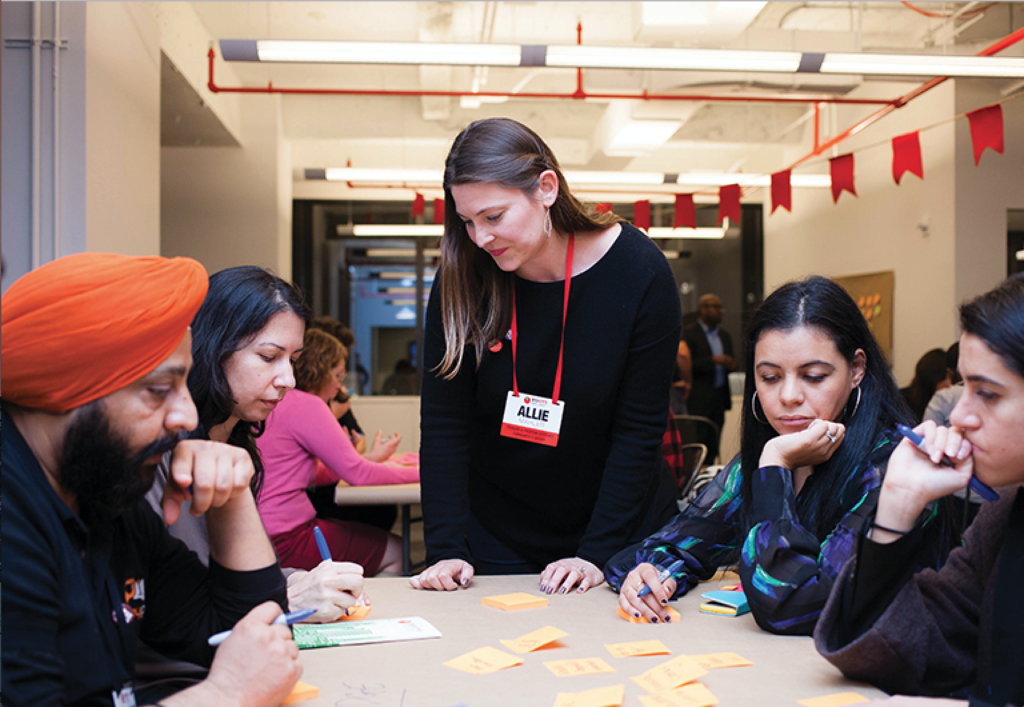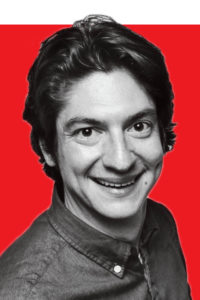
In her role as the executive director of the Impact Travel Alliance (ITA), a nonprofit organization linking global travel professionals with world-changing ambitions, Kelley Louise oversees a network that hosts approximately 70 educational events around the world each year, including ITA’s flagship Impact Travel Summit.
Louise, who lives in Brooklyn, said she makes an effort to make this summit into “more than just your average travel conference.” At a lot of conferences, people may learn something new, she said, but they also end up in a lot of sessions that aren’t necessarily relevant. “They leave with a stack of business cards — and also leave feeling a little bit overwhelmed.”
Moreover — considering ITA’s lofty goal of making sustainable travel a vehicle for combating global poverty and inequality — Louise wanted to make the Impact Travel Summit (formerly known as the Travel + SocialGood Summit) last November into a catalyst for change. ITA originally launched in partnership with the UN Foundation’s +SocialGood network, and has since grown to an independent nonprofit, although the connection spreading awareness of the United Nations projects remains: the 2017 Summit kicked off at the United Nations headquarters.
“My goal with this event,” Louise said, “was to do something more interactive and action-oriented, so that you were leaving the event, with not only having met people that you can collaborate with, but you’ve also planted the seeds toward building a more impactful future for the [travel] industry.”
For Louise, the big question was: “How can we take this very grand idea to transform the industry and break it down and do something so that we have something concrete after the summit that we can share with our community?”

really challenge
assumptions.’
She turned to Community By Design — a New York City–based consulting firm that specializes in precisely those kinds of challenges — to help design the summit. The firm was founded in 2016 by Allie Mahler, who, along with partner Scott Weiss, had previously worked at IDEO, the well-known global design firm based in Palo Alto, California. At IDEO, Mahler and Weiss were both steeped in principles of design thinking, a people-centered problem-solving process that IDEO helped to pioneer and bring into mainstream business.
As facilitators of dozens of workshops, the pair has seen how the design-thinking process worked successfully across many industries, Weiss said. In addition to ITA, Community by Design’s clients have ranged from a New York City synagogue that was wrestling with ways to engage teenagers with Jewish values and traditions to retreats for senior-level executives from Fortune 500 companies. “Allie and I in some fashion still apply design thinking to every single project we work on,” Weiss said. “And we’ve sort of molded it and shaped it to kind of suit the needs of the scale of work that we’re engaged in.”
Including adapting it to conferences, which are a great canvas for applying the design-thinking approach and philosophy, Weiss said. “You have a captive audience, you have a mission statement, if [a conference] is set up properly. What we’re learning is that we can layerin activities into the design-thinking process that can potentially lead to impact beyond the event.”
Here’s a four-step design-thinking approach to take with your events.
1 Gathering Inspiration
One of the foundational principles of design thinking could be described as putting aside the things that you think you know about what people need and want and looking at problems with fresh eyes.
Businesses — and conference organizers — traditionally have relied on tools including surveys and focus groups to try to understand what customers want. But design thinking goes far beyond that, using direct observation and a deep kind of questioning often called empathy interviewing, which seeks to understand users’ emotions, motivations, and unmet needs.
“If it’s snack-food innovation, you want to actually go into people’s homes and observe their snacking behaviors,” and then talk to them about those behaviors, Weiss said. “Within the confines of a workshop, we like to share examples of different research approaches that are driven by things like empathy — actually walking in the shoes of a user.”
And in the case of the ITA summit, that meant bringing users in for interviews — in this case, actual tourists. “Traditionally, in the travel sector, sustainable-tourism professionals have tended to talk to other sustainable tourism professionals,” Louise said. “Which is great when you find someone you can connect with, but at the same time, it can be a fault because then you’re preaching to the choir. Our strategy has always been, how can we reach outside of that core group and not only reach the activist travelers, but also reach your average consumers?”
“We want to really challenge assumptions in this process,” Weiss said. “So, instead of having [conference attendees] assume what tourists wanted, we actually had tourists come in and agree to be interviewed.”
At ITA, the tourists were interviewed by sustainable tourism professional attendees in groups of four, which were predesigned to include diverse points of view, mixing private- and public-sector attendees, as well as those with corporate and start-up backgrounds, Louise said. Members of each group had a similar vision of empowerment through travel, she added, but are accomplishing it through different ways. “A big focus is to connect those people so that they’re able to think outside of what they’re normally doing.”

solutions first.’
Design-thinking techniques can feel a little counterintuitive to those who are accustomed to focusing on solutions first, said Michael Glatts, Pfizer’s senior director for global congresses. Glatts led a group of more than two-dozen business-event strategists through a months-long exercise in applying design-thinking processes to medical meetings, and he and three of the exercise participants talked about their experience on a panel at PCMA’s Convening Leaders 2018 in Nashville.
“We all grew up in a world where we’re the experts and we have to come up with solutions,” Glatts said. Design thinking flips that impulse, asking practitioners to obsess — not over solutions, he said, but over problems.
“It was — at times — scary,” said Wanda Johnson, CMP, CAE, chief program officer for the Endocrine Society, who participated in the design-thinking initiative and spoke on the panel. “You didn’t know what the outcome would be” — and that’s not something that event organizers are accustomed to, she said. “We’re all folks who are used to solving problems — we know what we know. We had to step back from that and be willing to free fall a little bit and see where we ended up. [But] once you get out of the way of your own preconceived notions, and open yourself up to what people are telling you,” Johnson said, the benefits are enormous.
2 Generating Ideas
After the research phase, participants take the data and start to synthesize it, Weiss said, identifying patterns and themes across all of the data. “Storytelling is a really powerful tool” in this part of the process, he said. “You start to tell stories around some interesting interviews that took place and start to write down powerful quotes that you heard.”
Converting those observations into insights in the ideation phase is probably the toughest skill for any designer, Weiss said, “because you’re trying to make sense of all the noise.” The process uses brainstorming and other techniques to uncover opportunities and “big questions,” trying to hit the sweet spot between overly specific or overly broad questions in order to spark a compelling brainstorm. “It’s a democratic process, too,” he said. “At the end of that brainstorm, teams will vote on their favorite idea, an idea that can lead to a prototype.”
3 Making Ideas Tangible
Another pillar of design thinking is the value of quickly turning ideas into prototypes. Almost anything can be a prototype — creating a storyboard that describes a user experience or developing a skit, Weiss said. “Or you can fabricate a cardboard iPhone, and actually physically draw apps and describe a user experience that way,” he said. “We like to bring in Play-Doh and pipe cleaners and glue, so you’re tapping into that inner child.
“One of the stories I like to share before going into the prototyping phase,” Weiss continued, “is that if you go into any first-grade classroom all over the world and you ask the students if any of them are artists, every single hand will shoot up. If you ask them if they’re singers, they’ll start singing right away. It’s tough to get them to even stop singing. The idea is that you want to sort of abandon your inhibitions and tap into that inner seven-year-old who wasn’t self-conscious about how their artistic expression would be judged or perceived. So, it’s really removing judgment from the experience.”
Quickly creating physical representations of ideas, even those ideas that aren’t fully baked, is valuable, Weiss said. “It inspires a notion of possibility.” At the end of a brainstorming and prototyping session, he said, participants can say, “In three hours, we created an actual thing. Certainly, we haven’t tested its market viability yet, but here’s a thing that exists and if we could achieve that in three hours, think about if we applied this to a 12-week project cycle.”
[Design thinking is] really about feeling like you have permission to fail and experiment.
The teams of medical planners who worked with Glatts spent a few hours using craft materials — Styrofoam trays, sponges, pipe cleaners, paper cups, hair curlers, and more — to create prototypes that sought to address questions they formulated after talking with a variety of meeting stakeholders. For example: How can we change face-to-face interaction in the exhibit hall? After fabricating models of redesigned exhibit halls, and a prototype of a redesigned meeting app, the event strategists invited groups of users to critique their ideas and innovation, said Tonya Almond, CMP, PCMA’s vice president of knowledge and experience. “We were iterating and reiterating on the fly,” said Almond. The experience illustrates one of the strengths of designing thinking, Glatts said. “It’s designed to find out where [your ideas] will fail.” If you go through a few design-thinking workshops, “you sort of get it,” Weiss said. “It’s really about feeling like you have permission to fail and experiment.”
4 Share the Story
What happens next? At many conferences, energy and enthusiasm “kind of deflates at the end,” if there is no plan for purposeful collaboration beyond the event, Weiss said. For the ITA Summit, Louise worked with a research company to compile a white paper, which collects the ideas generated at the summit in a concise way, she said. The report is not only sent to attendees, but made available to ITA’s global community for free.
We’re generating action-oriented results.
“You leave the conference not only feeling inspired, but also knowing that you’ve started to build something that will push the industry forward,” she said. “We’re not just talking about sustainable tourism, we’re generating action-oriented results.” For weeks after the summit, attendees were emailing Louise to tell her that the conference had left them feeling reenergized, not just about sustainable travel, but their own career paths, she said. “They said, ‘This is the best conference that I’ve ever been to — I’m still buzzing, I have so many ideas for my business.’” If it has an impact on attendees for the rest of their careers, Louise said, that “is a huge reward for putting so much time and effort into a two-day summit.”
Read more on design thinking with “Are You Designing for Goosebumps?”
Test Time:
Earn one clock hour of certification credit. Once you’ve finished reading this article, read the following material:
› “5 Stages in the Design Thinking Process,” by the Interaction Design Foundation at convn.org/5-stages-design-thinking.
› “7 Do’s and Don’ts: The Latest Trends in Design Thinking,” a blog post based on an attendee’s takeaways at a business-design thinking forum at convn.org/SAP-design-thinking.
To earn certification clock hours, visit pcma.org/convene-cmp-series to answer questions about information contained in this CMP Series article and the additional material.
The Certified Meeting Professional (CMP) is a registered trademark of the Events Industry Council.



